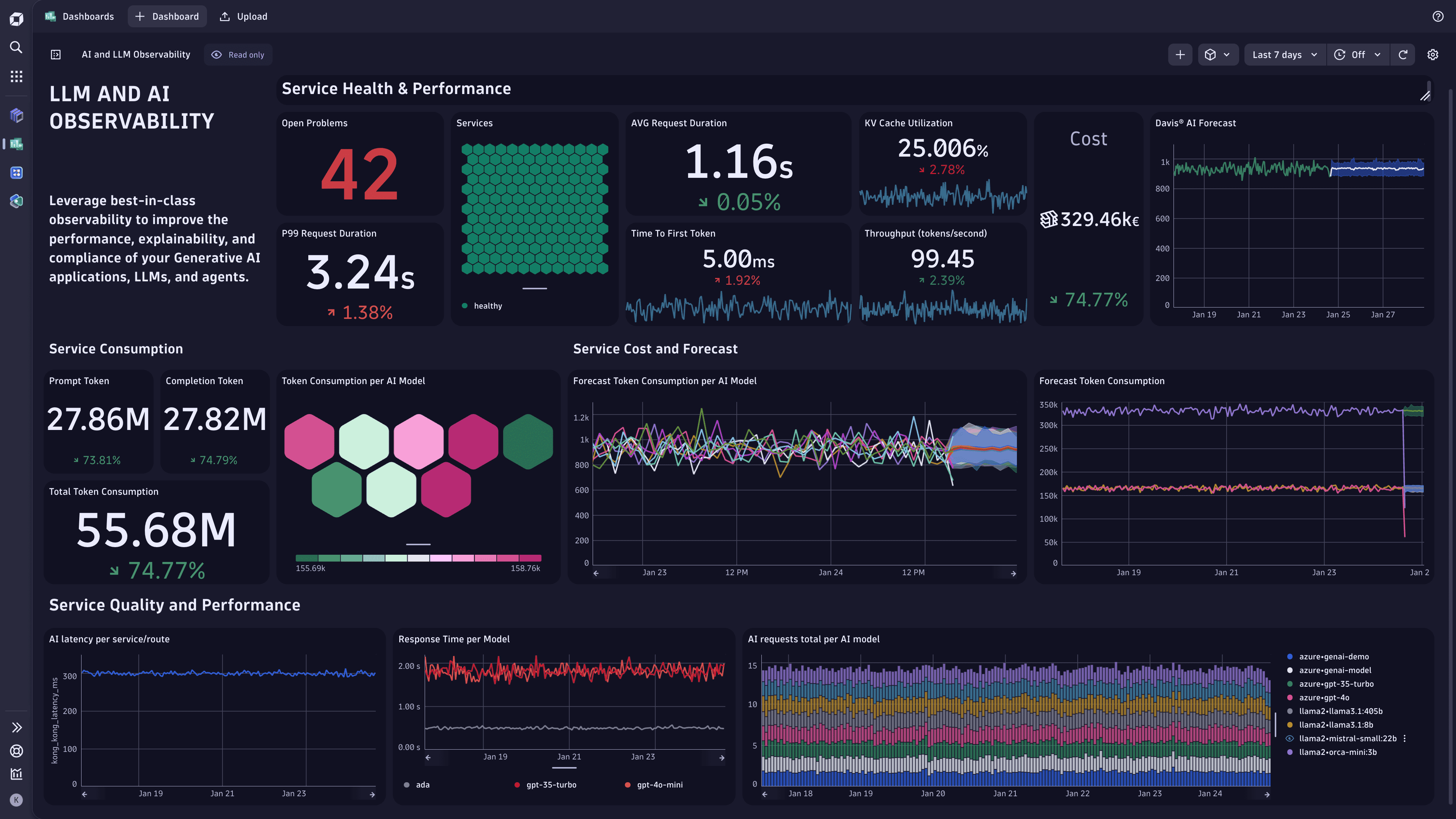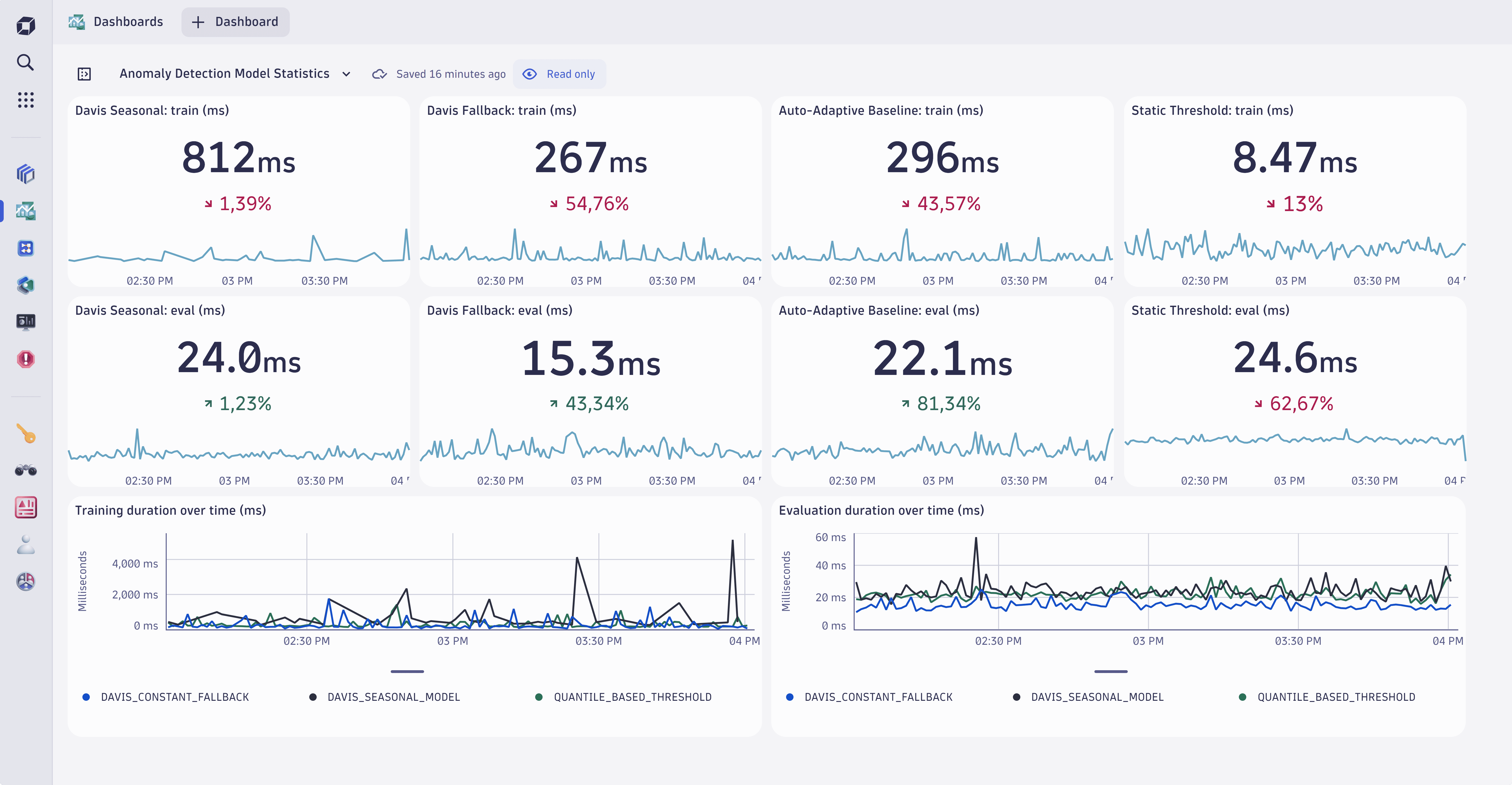AI and LLM Observability
- Latest Dynatrace
- Overview
- 4-min read
AI observability is the practice of monitoring, analyzing, and visualizing the internal states, inputs, and outputs of AI models embedded in modern applications. It helps ensure correctness, reliability, and effectiveness, while also supporting compliance requirements. By observing AI systems, data scientists, engineers, and operators can uncover insights to optimize and refine performance of your whole stack.
AI architectures are often complex, dynamic, and probabilistic, operating in unpredictable environments. Observability and transparency are critical to detect biases, understand limitations, and identify potential issues—an emphasis highlighted by emerging regulations like the European Union Artificial Intelligence Act.
Dynatrace end-to-end AI and LLM observability
Dynatrace unifies metrics, logs, traces, problem analytics, and root cause information in dashboards and notebooks, providing a single operational view of your AI-powered cloud applications end-to-end.
Use Dynatrace with Traceloop OpenLLMetry to gain detailed insights into your generative AI stack.

This approach covers the complete AI stack, from foundational models and vector databases to RAG orchestration frameworks, ensuring visibility across every layer of modern AI applications.
Key metrics for AI observability
- Stability: Frequency of successful model responses vs. failures.
- Latency: Time taken by models or services to return results.
- Load: Volume of requests handled; identify abnormal load spikes or drops.
- Model drift: Changes in model accuracy due to shifting input data.
- Data drift: Monitoring input data stationarity to anticipate model drift.
- Cost: Token usage, service fees, or overall resource consumption.
Observing AI models is inherently domain-driven: model owners must expose critical logs, metrics, and data to enable effective monitoring.
Dynatrace Platform capabilities
- Monitoring: Continuous collection and analysis of model metrics, events, logs.
- Logging: Captures relevant events and errors for debugging and post-mortem analysis.
- Metrics & Performance Analysis: Dashboards and notebooks for performance trends.
- Visualization: Domain-specific dashboards to quickly identify patterns and issues.
- Anomaly Detection: Automated alerts for deviations from normal patterns.
- Explainability & Interpretability: Techniques to illuminate a model's decision-making process.

Key use cases for AI observability
- Monitor service health and performance: Track real-time metrics (request counts, durations, and error rates). Stay aligned with SLOs.
- Monitor service quality and cost: Implement error budgets for performance and cost control. Validate model consumption and response times. Prevent quality degradation by monitoring models and usage patterns in real time.
- End-to-end tracing and debugging: Trace prompt flows from initial request to final response for quick root cause analysis and troubleshoot. Gain granular visibility into LLM prompt latencies and model-level metrics. Pinpoint issues in prompts, tokens, or system integrations.
- Build trust, reduce compliance and audit risks: Track every input and output for an audit trail. Query all data in real time and store for future reference. Maintain full data lineage from prompt to response.
By embracing AI observability, organizations improve reliability, trustworthiness, and overall performance, leading to more robust and responsible AI deployments.
Observing model providers and platforms
Dynatrace integrates with providers such as OpenAI, Amazon Bedrock, NVIDIA NIM, Ollama to monitor performance (token consumption, latency, availability, and errors) at scale.
Observing semantic caches and vector databases
Vector databases and semantic caches are central to RAG architectures. Dynatrace monitors solutions like Milvus, Weaviate, and Qdrant to help identify performance bottlenecks and usage anomalies.
Observing orchestration frameworks
Frameworks like LangChain manage data ingestion and prompt engineering for RAG applications. Dynatrace ensures you can track performance, versions, and degradation points in these pipelines.
Observing infrastructure and resources
Monitor infrastructure usage (GPU/TPU metrics, temperature, memory, etc.) for cloud services such as Amazon Elastic Inference and Google TPU, or custom hardware like NVIDIA GPU. This helps optimize resources and supports sustainability initiatives.
An overview of all of our integrations can be found on our Dynatrace Hub page
AI observability provided by Dynatrace
Dynatrace, a software intelligence company, has implemented its own AI observability solution to monitor, analyze, and visualize the internal states, inputs, and outputs of its own AI models.
The example below shows one of many self-monitoring dashboards that Dynatrace data scientists use to observe the operation of Davis® AI across all monitoring environments.

